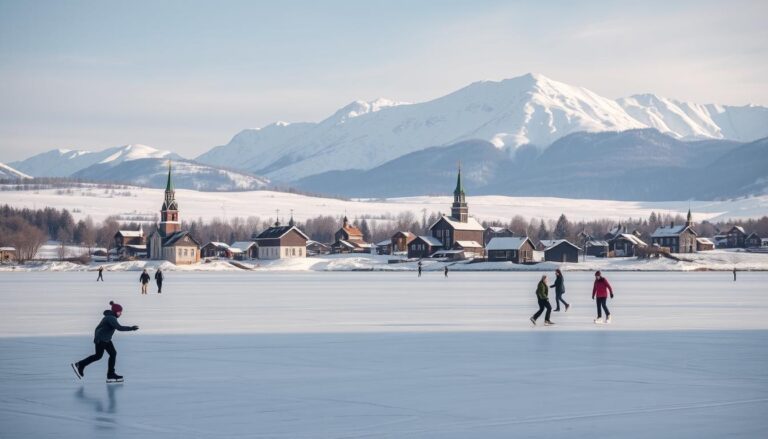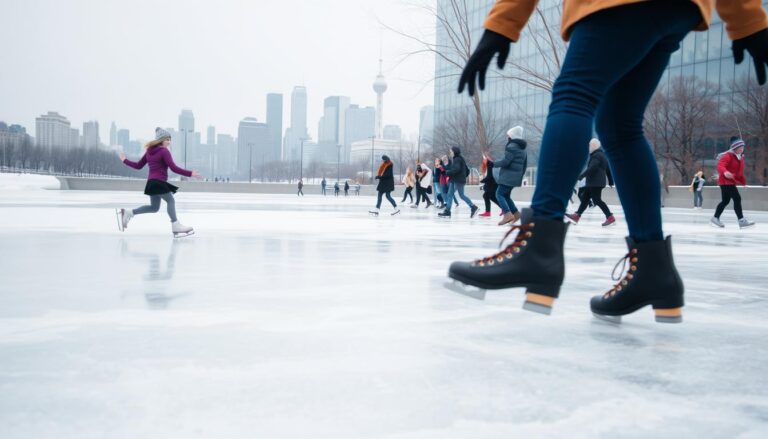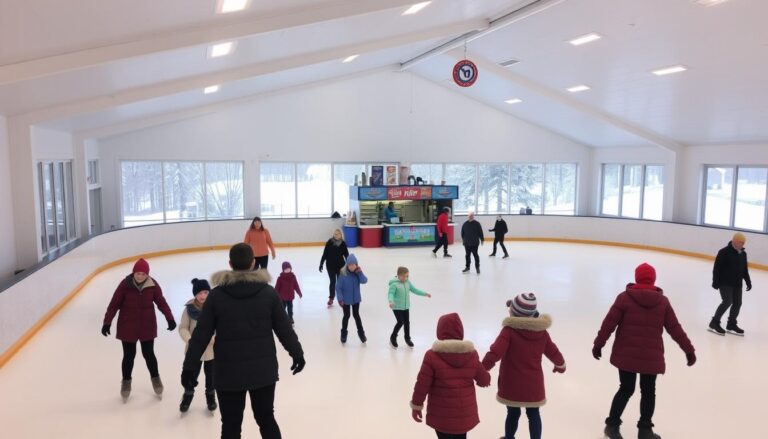What Muscles Does Ice Skating Work? The Lower Body
Ice skating is more than just a winter activity. It’s a full-body workout that changes your lower body muscles in unexpected ways. When you step onto the ice, you’re not just gliding. You’re working a complex network of muscles for smooth, powerful movements.
Ice skating reveals a surprising fitness secret. Every move you make activates many muscles at once. This makes it a very effective workout for your lower body. Skaters, whether pros or weekend warriors, build strong legs and glutes through this sport.
The magic of ice skating happens in your legs, core, and stabilizing muscles. Your quadriceps, hamstrings, glutes, and calves become powerful. Your body turns into a precise instrument, moving smoothly with balance and momentum.
Professional skaters know that muscle engagement is key. Each stroke requires balance, strength, and coordination. Recreational skaters can also build muscle, making ice skating a fun and serious workout.
Exploring ice skating muscles reveals a holistic workout. It challenges your body in unique ways. Whether you’re new or experienced, knowing how muscles work can improve your skating and prevent injuries.
This guide will show how different muscles help your skating. You’ll learn about the muscle interactions that make ice skating a full-body exercise. It changes how you see this elegant sport.
Ready to learn about ice skating’s muscular mechanics? Get ready to discover the secrets of lower body strength, balance, and power. This winter sport is a remarkable fitness experience.
Understanding the Fundamentals of Ice Skating Muscles
Ice skating is more than just gliding on the ice. It’s a full-body workout that uses many muscles at once. When you step onto the ice, your body turns into a powerful machine.
Knowing which muscles ice skating uses can help you improve your skills. It also lets you see the exercise benefits in each movement.
Basic Muscle Engagement in Skating Movement
Every skating stroke is a complex dance of muscle activation. The main muscles used in ice skating are:
- Quadriceps: Powering forward momentum
- Glutes: Generating propulsive force
- Hamstrings: Stabilizing leg movements
- Calves: Providing balance and edge control
Role of Proper Form in Muscle Activation
Good skating form is key for effective muscle use. Alignment matters. Keeping the right posture helps:
- Distribute muscle workload evenly
- Reduce injury risk
- Maximize ice skating exercise benefits
- Improve overall skating efficiency
Dynamic vs. Static Muscle Usage
Ice skating works muscles in two ways: dynamic and static. Dynamic muscle use happens during active gliding and pushing. Static use helps keep balance and stability.
Understanding these muscle mechanics helps skaters create better training plans. This unlocks their full ice skating abilities.
Primary Lower Body Muscle Groups in Ice Skating
Ice skating requires strong legs and good coordination. It shows us which muscles are key for moving smoothly on ice. These muscles work together to make skating movements powerful and smooth.
The main muscles in the legs for ice skating are:
- Quadriceps (front thigh muscles)
- Hamstrings (back thigh muscles)
- Glutes (buttock muscles)
- Calves
- Hip flexors
Each muscle group is vital for skating. They help with power, balance, and precise moves. The constant motion of skating builds strong legs.
| Muscle Group | Primary Function in Skating | Key Movement |
|---|---|---|
| Quadriceps | Power generation | Forward propulsion |
| Hamstrings | Stabilization | Backward pushing |
| Glutes | Hip rotation | Lateral movement |
| Calves | Edge control | Balance and precision |
Skaters get better muscle control with practice. Their legs become strong and quick, making skating look easy. The muscles work together for the smooth, athletic moves of ice skating.
What Muscles Does Ice Skating Work: Complete Analysis
Ice skating is a dynamic workout that engages multiple muscle groups at once. Knowing how these muscles work together can help you skate better and avoid injuries. Let’s look at how different muscles help you glide smoothly on the ice.
Ice skating muscles are key for powerful and graceful movements. Skating’s complexity demands precise muscle coordination and strength in various body parts.
Front Leg Muscles Engagement
Your front leg muscles are the main drivers in ice skating. They push you forward and keep you balanced through complex movements. Key muscles include:
- Quadriceps: Responsible for knee extension
- Hip flexors: Enable forward momentum
- Adductor muscles: Provide stability during lateral movements
Back Leg Muscle Activation
The back leg muscles also work hard during skating, providing power and support. They help in:
- Generating push-off force
- Maintaining balance
- Controlling deceleration
Supporting Muscle Groups
Many supporting muscle groups also play a role in effective skating:
| Muscle Group | Primary Function | Skating Impact |
|---|---|---|
| Core Muscles | Stabilization | Maintains balance and posture |
| Glutes | Power generation | Enables strong directional changes |
| Lower Back | Postural support | Prevents fatigue during extended skating |
Pro tip: Developing muscle awareness can significantly improve your skating technique and overall performance.
Quadriceps Development Through Ice Skating
Ice skating turns your quadriceps into strong muscle machines. These front thigh muscles are key to your skating power. They help you glide smoothly and turn with ease.
Your quadriceps are vital for ice skating fitness. They work hard during skating, giving you:
- Balance and stability while skating
- Power for moving forward
- Support for complex moves
- Strength for jumps and spins
Dynamic skating movements keep your quadriceps strong. Every push-off works your legs hard. This makes ice skating a great workout for your lower body.
Regular skating builds strong quadriceps. Skaters see muscle growth and endurance in their front thighs. Beginners might see muscle tone in just weeks.
Professional skaters have incredibly strong quadriceps. Their muscles are well-defined and powerful from lots of training.
- Beginners: Start with basic skating techniques
- Intermediate skaters: Focus on controlled movements
- Advanced performers: Incorporate complex routines
Knowing how your leg muscles work in ice skating is key. Your quadriceps are the base of your skating ability.
The Role of Glutes in Ice Skating Performance
Ice skating is a dynamic sport that demands significant muscle engagement, mainly in the glutes. Understanding how these powerful muscles contribute to skating performance can transform your approach to this exhilarating activity. What muscles does ice skating work? The glutes play a key role in generating power and maintaining stability on the ice.
Glutes are fundamental to ice skating workout muscles, providing the essential strength and power needed for precise movements. They work in harmony to create smooth, efficient skating techniques that look effortless but require intense muscle activation.
Gluteus Maximus Activation
The gluteus maximus, the largest muscle in the body, becomes a powerhouse during ice skating. This muscle activates during:
- Pushing off the ice during forward motion
- Maintaining balance during complex skating maneuvers
- Generating explosive power for jumps and quick directional changes
Hip Stabilizer Engagement
Ice skating workout muscles extend beyond simple movement. Hip stabilizers work continuously to:
- Provide lateral support during skating
- Prevent unnecessary body movements
- Enhance overall skating precision
Power Generation Through Glutes
Powerful glutes translate directly into skating performance. Skaters who develop strong gluteal muscles can expect improved:
- Speed
- Endurance
- Technical skill
By focusing on glute strength and activation, skaters can unlock their full performance on the ice. This transforms ice skating from a passive experience to an active, powerful performance.
Hamstring Engagement During Skating Movements
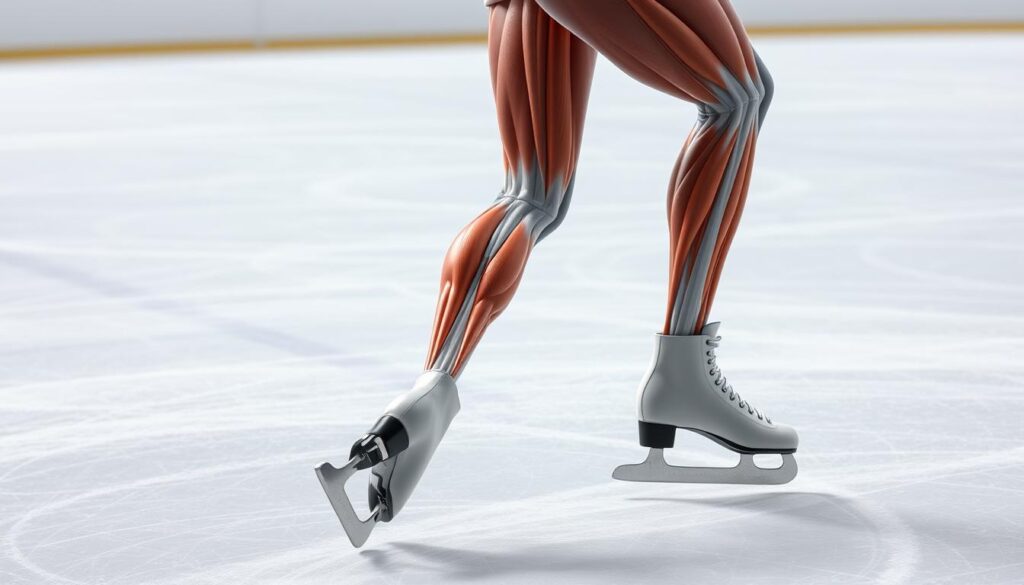
When you glide across the ice, your hamstrings play a key role. They help make your movements smooth and powerful. These muscles at the back of your thigh work hard during ice skating.
Ice skating leg muscles work together in a complex way. Hamstrings are key for support and power. They help you:
- Generate forward momentum
- Stabilize your leg during gliding
- Control deceleration and direction changes
- Maintain proper body alignment
The biomechanics of skating require strong hamstrings. Each stride needs these muscles to contract and extend quickly. This creates the dynamic motion that makes skating look effortless. Professional skaters have strong hamstrings, which improves their performance.
Skaters can improve hamstring strength with specific exercises. These include:
- Single-leg deadlifts
- Nordic hamstring curls
- Stability ball leg curls
- Skating-specific plyometric training
Understanding and strengthening your hamstrings can greatly improve your skating. It reduces injury risk and boosts power and efficiency on the ice.
Calf Muscles: The Foundation of Ice Skating
Ice skating is a great workout for your lower body, with calf muscles being key. These muscles are heroes when you skate, helping you move smoothly. Knowing how they work can make you a better skater.
Your calf muscles are vital for power, balance, and precise movements. They work hard to keep you stable and moving smoothly on the ice.
Gastrocnemius Development in Skating
The gastrocnemius muscle in your calf gets a lot of work from skating. It helps you:
- Generate explosive push-off power
- Maintain balance during complex skating movements
- Create smooth transitions between skating techniques
Soleus Muscle Function in Ice Skating
The soleus muscle, under the gastrocnemius, is also important. It helps keep your ankle stable and supports your weight during tough moves.
| Muscle Group | Primary Function | Skating Impact |
|---|---|---|
| Gastrocnemius | Power Generation | Explosive Movements |
| Soleus | Stabilization | Balance Maintenance |
Pro Tip: To strengthen your calf muscles for skating, do exercises like calf raises, jump squats, and plyometric movements. These mimic skating actions.
Strong calf muscles are essential for better ice skating. They boost your power, stability, and overall performance. Focus on these muscles to take your skating to the next level.
Core Strength and Its Impact on Skating
Your core is key to every move on the ice. It turns an average skater into a pro. When you skate, your abs and lower back keep you balanced and powerful.
Having a strong core does more than just help you skate. It builds a base of strength for all athletic moves. A strong core helps you:
- Maintain perfect body alignment
- Generate explosive power during jumps
- Stabilize your body during complex skating techniques
- Prevent skating-related injuries
Professional skaters know core strength is more than abs. It’s about a solid base that links your upper and lower body. Your spine and pelvis muscles work together for smooth movements.
For ice skating, focus on exercises that mimic skating. Try planks, Russian twists, and balance board workouts. These improve your skating skills. With core training, you’ll get more agile and powerful.
Hip Flexors and Their Role in Ice Skating

Ice skating requires top-notch muscle coordination, with hip flexors being key. These muscles are vital for smooth, dynamic movements on the ice. Knowing how they work can improve your skating and athletic skills.
Hip flexors are essential for ice skating’s muscle mechanics. They link your upper and lower body, making complex movements possible. As important ice skating muscles, they help with powerful glides, quick turns, and precise footwork.
Dynamic Movement Patterns
Hip flexors are central to ice skating’s dynamic movements. They control:
- Forward propulsion
- Lateral shifting
- Balance during complex skating maneuvers
- Smooth transitional movements
Flexibility Requirements
Good hip flexor performance needs regular flexibility exercises. Skaters should stretch to improve range of motion and avoid injuries. Adding flexibility work can greatly boost your skating efficiency.
Recommended stretches include:
- Lunges with rotation
- Pigeon pose stretches
- Dynamic hip opening movements
- Controlled leg swings
By focusing on your hip flexors, you can reach new heights in skating. This will enhance your on-ice performance through targeted muscle development.
Upper Body Muscle Involvement in Ice Skating
Ice skating is more than just a leg workout. Your upper body is key to your performance and technique. It shows that ice skating is a full-body exercise.
Skaters use their arms and shoulders to stay balanced and move fast. These muscles are vital for different skating styles. Whether you’re gliding in figure skating or making quick moves in hockey, your upper body is hard at work.
- Shoulders engage for stability and arm positioning
- Back muscles support core rotation and balance
- Arms help generate power during skating movements
Ice skating also strengthens your upper body. Your deltoids, trapezius, and latissimus dorsi muscles get a great workout. This is thanks to the constant arm movements and body positioning.
Different skating styles work your upper body in unique ways:
- Figure skating: Focuses on elegant arm movements and body control
- Hockey skating: Needs strong, dynamic upper body movements
- Speed skating: Emphasizes aerodynamic body positioning and arm swings
Adding upper body strength training to your skating can boost your performance. It also helps develop your muscles on the ice.
Building Strength for Better Ice Skating Performance
Ice skating is more than just moving on the ice. A good fitness routine can make you skate better and avoid injuries. It’s important to work on muscle strength, flexibility, and conditioning.
Good fitness for ice skating means better muscle control, more endurance, and balance. Skaters can reach their best by doing exercises that match their skating needs.
Strategic Training Approach
A good strength training plan for ice skaters should cover several areas:
- Lower body strength development
- Core muscle stabilization
- Flexibility and range of motion exercises
- Cardiovascular conditioning
Cross-Training Strategies
Cross-training is key for ice skating fitness. Different activities can help skating workouts:
- Cycling: Builds leg strength and heart health
- Swimming: Works the whole body with less stress
- Yoga: Boosts flexibility and core strength
- Plyometric exercises: Increases power for jumps and quick moves
Adding these cross-training methods helps skaters build a strong, flexible body. This leads to better skating performance.
Injury Prevention Through Muscle Balance
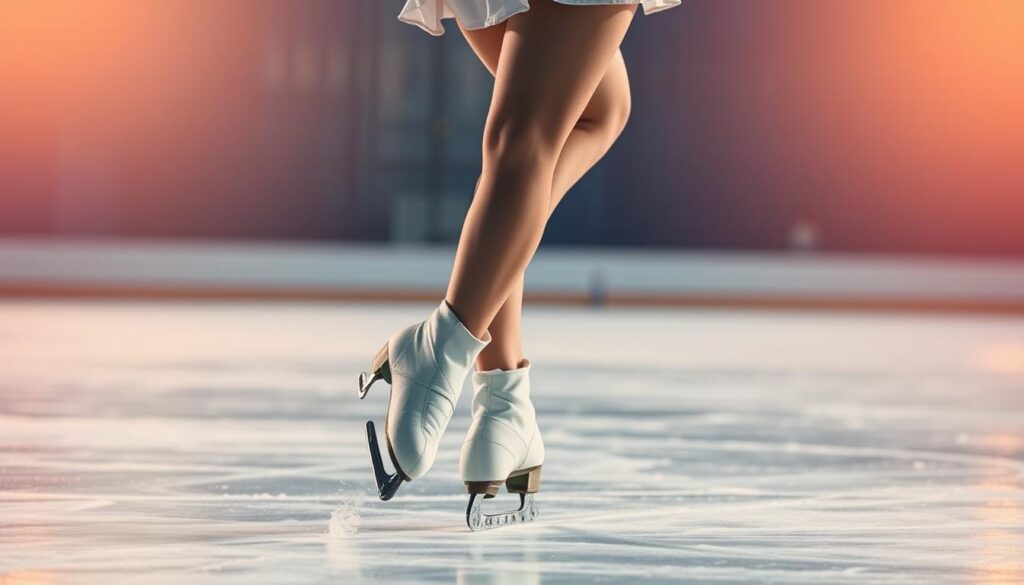
Ice skating not only improves your skills but also helps prevent injuries. Knowing which muscles are used in ice skating is key to staying safe and fit.
Muscle imbalances can lead to injuries. If some muscles are stronger than others, your body is at risk for strains and more serious injuries.
- Identify muscle weakness patterns
- Develop targeted strengthening routines
- Create symmetrical muscle development
- Practice consistent flexibility training
Skaters need to focus on balanced muscle engagement across different muscle groups. This means building equal strength in:
| Muscle Group | Key Focus Areas | Injury Prevention Strategy |
|---|---|---|
| Quadriceps | Front thigh muscles | Balanced leg strength exercises |
| Hamstrings | Back thigh muscles | Stretching and flexibility work |
| Core Muscles | Abdominal and lower back | Stabilization training |
Regular checks with a sports physiotherapist can spot muscle imbalances early. By keeping muscles balanced, skaters lower their injury risk and boost their performance.
Progressive Muscle Development for Beginners
Stepping onto the ice for the first time can feel both exciting and intimidating. Your journey into ice skating fitness starts with learning how to build muscles safely and effectively. Ice skating workout muscles need a careful plan that builds strength slowly.
New skaters often don’t realize how many muscles are used in this sport. Ice skating fitness benefits go beyond just heart health. It works many muscle groups at once.
Starting Safely: Building Your Foundation
Your first goal should be to strengthen your core and lower body. Experts suggest a step-by-step approach to muscle building:
- Start with off-ice stability exercises
- Practice balance-specific movements
- Incorporate light resistance training
- Gradually increase intensity and complexity
Muscle Progression Strategy
Building ice skating workout muscles takes patience and regular practice. Beginners should focus on:
- Quadriceps strengthening through bodyweight squats
- Ankle stability exercises
- Core engagement techniques
- Flexibility training
Experts say start with 2-3 targeted workout sessions a week. These should build basic strength without overdoing it. The goal is to build muscle memory and adapt to skating movements slowly.
Remember, every pro skater began where you are now. Enjoy the learning, listen to your body, and see the amazing ice skating fitness benefits with regular practice.
Advanced Muscle Training Techniques for Skaters
Elite ice skaters know that strength training is more than basic exercises. They use special techniques to improve their skating. These techniques make their skating performances stand out.
For advanced muscle development, skaters focus on specific muscles used in skating. Knowing which muscles are worked by skating is key to creating effective training plans.
- Plyometric Power Training: Explosive jump exercises that mimic skating movements
- Resistance Band Skating Simulations: Develop muscle strength through controlled resistance
- Unilateral Leg Strength Workouts: Enhance balance and individual leg power
Professional skaters use periodization training to build muscle. This method changes the intensity of workouts to keep muscles growing. It helps avoid plateaus and ensures muscle adaptation.
Important advanced training techniques include:
- Dynamic Stability Exercises: Improve core strength and muscle coordination
- Sport-Specific Strength Circuits: Replicate on-ice muscle engagement patterns
- Progressive Overload Training: Gradually increase workout intensity
Safety is always a top priority. Always talk to professional trainers before starting advanced techniques. This helps prevent injuries while building skating-specific muscle strength.
Recovery and Muscle Care for Ice Skaters
After a tough ice skating session, your muscles need special care. This care helps keep you performing well and avoids injuries. Ice skating does more than just improve your skills on the ice. It also boosts your muscle health and growth when you recover right.

Keeping your muscles in top shape is key for ice skating. Skaters must be just as dedicated to recovery as they are to training.
Essential Post-Skating Recovery Methods
Good recovery starts right after you skate. Here are important steps to help your muscles heal:
- Drink lots of fluids with electrolytes
- Eat protein within 30 minutes of skating
- Use heat or cold on sore muscles
- Get enough rest for muscle repair
Muscle Maintenance Techniques
Special care for your muscles can make you a better skater and lower injury risks. Here are some advanced tips:
- Stretching Routine: Use dynamic stretches that match skating moves
- Use foam rolling to ease muscle tightness
- Get regular sports massages for deep muscle healing
- Stick to a sleep schedule for muscle repair
By using these recovery methods, you’ll keep your muscle strength up. This means you’ll skate better for longer.
Conclusion
Ice skating is more than just fun on the ice. It’s a workout that boosts your heart and strengthens your body. Every step you take works out your legs, core, and more.
Skating is special because it builds strength, balance, and coordination. It helps you get leaner, boosts your heart health, and improves your body awareness. It’s a workout that’s hard to find in the gym.
Every time you skate, you’re getting stronger and more flexible. Skating is great because it’s easy on your joints but works your muscles hard. It’s perfect for anyone looking to get fit.
Want to get better at skating? Keep practicing and focus on your technique. You’ll see amazing changes in your body as you enjoy the thrill of skating.


